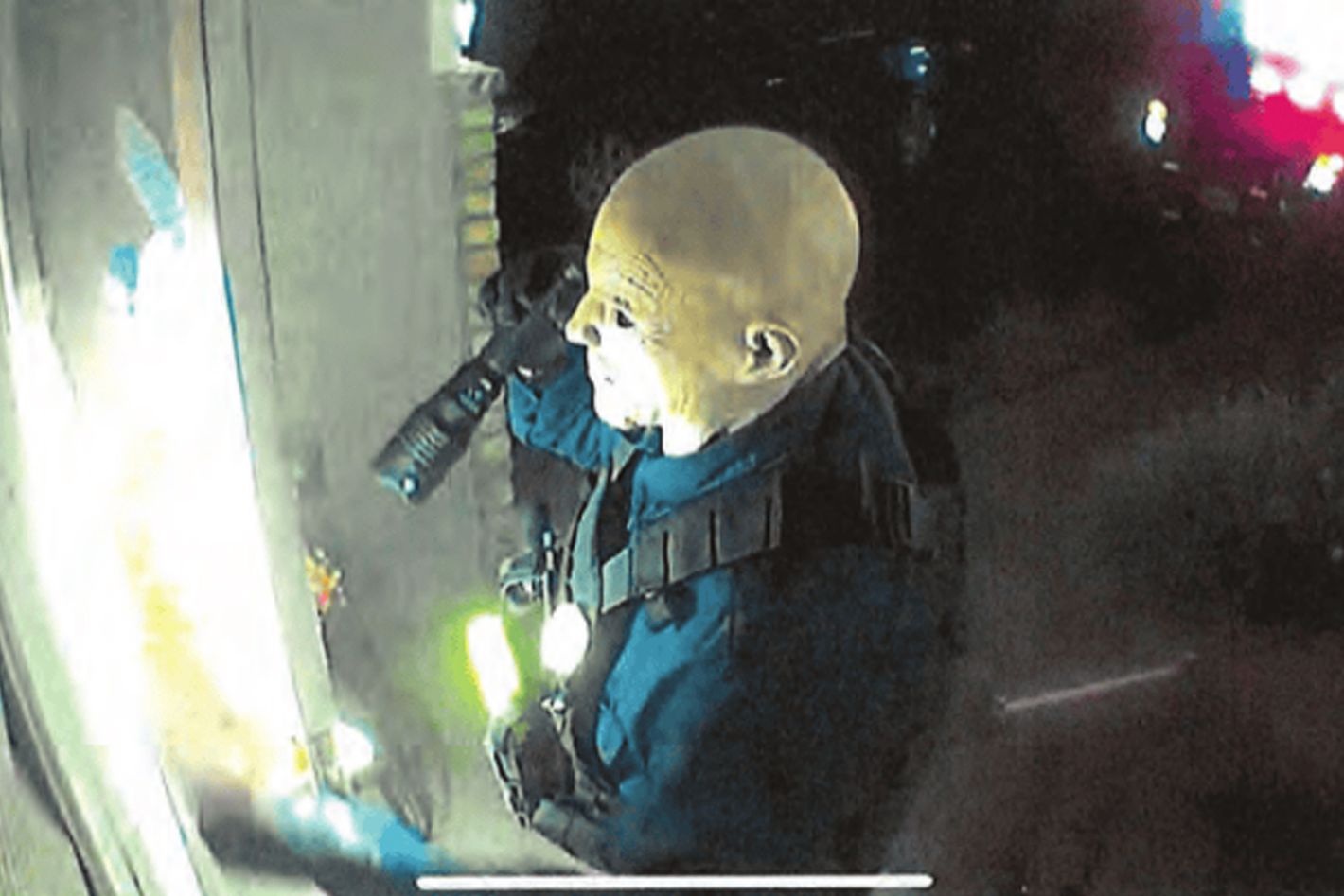 Photo: U.S. District Court for the District of Minnesota
Photo: U.S. District Court for the District of Minnesota
Since President Trump reassumed office, the United States has been subjected to a dramatic spike in law enforcement, with often brutal ramifications. With a new daily quota of 3,000 arrests, federal immigration authorities have called on a range of local police agencies to help round up immigrants and dissidents while Trump has deployed the National Guard and the Marines to run interference for the Feds during raids — an unprecedented blitz that spans big cities, small towns, and rural farmlands. This immigration dragnet will only get wider after Congress passed a megabill this month that will triple ICE’s budget by 2028, likely making domestic immigration enforcement more expensive than funding the Marine Corps.
Just as striking as the scale of these operations has been their subterfuge: Agents wear face masks to conceal their identities and routinely drag prisoners away while dressed in street clothes that do not identify them as law-enforcement officials at all. Their signature wardrobe accessories — neck gaiters or balaclavas that cover their faces, bulletproof vests over graphic tees — are often indistinguishable from those preferred by hate groups like Patriot Front or by the very criminal syndicates that Trump claims to be going after with his raids. When these agents suddenly charge at people inside a local courthouse, entrap pedestrians alone on the sidewalk, or ram into unsuspecting motorists with their unmarked vehicles, like they did in June to a man in Los Angeles who had a toddler and an infant in the backseat of his car, they look and act like vigilantes.
Impostors have taken notice. Crooks pretending to be ICE officials have attempted an astonishing variety of schemes: A woman in Bibb County, Georgia, was recently detained at work by another woman who identified herself as an ICE agent — only to realize as she was being driven away that the “agent” was actually a kidnapper. A man in Houston also claiming to represent ICE conducted a fake traffic stop, robbing a motorist of his cash and ID. While impounding an illegally parked vehicle, cops in Huntington Park, California, recently found a loaded gun and official-looking documents with DHS headings inside. Among an alarming array of other instances, ICE impersonators have detained a car full of Hispanic motorists in Charleston, South Carolina; invaded a residence hall at Temple University in Philadelphia; and sexually assaulted a woman at a Motel 6 in Raleigh, North Carolina, threatening to deport her if she reported him.
All of these transgressors saw opportunity in the increased lawlessness that is a hallmark of Trumpism, a movement known for degrading the actual law in favor of weaponizing law enforcement and deputizing everyday citizens to carry out the president’s agenda. Right-wing vigilantes are not just enabled but celebrated as heroes — like the nearly 1,600 people the president pardoned for storming the Capitol on January 6, 2021, some of whom were current or former law enforcement. Daniel Penny, an ex-marine who strangled and killed a Black busker on a New York City subway car in 2023, was even invited by Vice-President JD Vance to Trump’s suite at Super Bowl LIX. “One of the most significant stages of the rise of a fascist society is not the stage where the government itself controls all the violence,” said Alec Karakatsanis, founder of Civil Rights Corps, an organization focused on civil-rights litigation. “It’s the conditions that the government creates for vigilante violence, and the parameters it sets up so that vigilantes targeting certain groups of people know that no constraints are going to be imposed by the state.”
Proving how conditional the notion of policing as a symbol of public safety truly is, one of the second Trump administration’s signature accomplishments has been to create a sense that anyone can be a target, which is made possible by the corresponding impression that anyone can be a cop.
There is no legal statute that requires immigration agents to wear uniforms, and legislation governing identification and local police is a patchwork, which makes it harder to not only distinguish between law enforcement officials and vigilantes but to identify and punish real cops who abuse their power. “In Title VIII of the U.S. Code, it says an immigration officer at the time of arrest has to identify themselves, but it’s an open legal question of whether or not the masks run counter to that legal requirement,” said Rena Karefa-Johnson, who runs national initiatives at FWD.us, an advocacy organization focused on mitigating the harms of the criminal justice system. “Which kind of just speaks to the incredible weakness of our legal system in holding law enforcement accountable.”
Subterfuge may even incentivize cops to be more violent: A 2018 study by the Intercept found that plainclothes NYPD officers constituted 6 percent of the force but were involved in 31 percent of fatal police shootings over the previous 18 years. It helps explain the license that masked ICE agents feel to assault not the kind of imminently dangerous people Trump promised to target, but the dishwashers, day laborers, and blue-collar workers who seem to more frequently find themselves in his crosshairs.
The government, for its part, has argued that face coverings are necessary to protect agents from getting doxed. “That’s a tool that the men and women of ICE [use] to keep themselves and their family safe,” Todd Lyons, the agency’s acting director, told CBS’s Face the Nation. But Democratic lawmakers in California, New York, Massachusetts, and other localities are weighing bills that would outlaw the practice — precisely because anonymity has empowered law enforcement to act with impunity. At an anti-ICE protest last month, a group of activists that included Shakeer Rahman, a Los Angeles–based lawyer who maintains an identification database of LAPD officers called Watch the Watchers, was shot several times with less-lethal munitions by a cop who had removed his name and badge number from his uniform and refused to verbally identify himself. The cop was eventually clocked by activists as Rick Linton — in part because his wife is an avidly self-promoting cop-wife influencer on Instagram. “They’re all happy to identify themselves when it comes to promoting themselves,” said Rahman. “It’s as soon as you put those records in the hands of people where they’re used for any kind of accountability or transparency that they feel threatened.”
It’s a terrifying atmosphere in which vigilantes and masked villains, eager to exploit the ambiguity around who is in charge, are able to more efficiently take advantage of the public. But it’s also a harbinger of worse things to come from this right-wing administration — a bigger police state with deteriorating standards of conduct, where even real cops are starting to have trouble telling themselves apart from the fakes.
This was the case on June 14, at around 2:30 a.m., when an officer with the New Hope police department in Minnesota drove to the home of state senator Ann Rest, where he’d been assigned to do a safety check following the shooting of two state lawmakers in nearby Champlin. The officer noticed that one of his colleagues had apparently beaten him to the scene: A black SUV with police lights attached to the roof was parked down the block, and when he pulled up alongside it, the officer noticed that the driver was wearing police gear like him — a black tactical vest, a Taser, a flashlight, and a badge. Yet in spite of the officer’s attempts to strike up a conversation, the driver “just sat there and stared straight ahead,” according to U.S. Attorney for Minnesota Joseph Thompson. Soon after the cop gave up trying to talk to him, 57-year-old Vance Boelter, allegedly drove to neighboring Brooklyn Park and killed Minnesota House Democratic Leader Melissa Hortman and her husband, Mark — his second shooting of the night, after the lawmakers in Champlin earlier.
Bob Jacobson, the commissioner of the Minnesota Department of Public Safety, lamented that Boelter had been able to fool the police officer and escape because the alleged assassin had “exploited the trust our uniforms are meant to represent.” But that sense of incredulity looks increasingly naïve as, across the country, trust in law enforcement has rarely been more under threat — echoing, in key ways, the falling-out the public had with the police during the uprisings of 2020.
Ultimately, it’s not a problem that dressing ICE agents in better uniforms will fix. Rahman, the L.A.-based lawyer, notes that the scale of abuses visited on innocent people today will erode law enforcement’s legitimacy overall. “That’s why they’re masking,” he said. “It’s because everybody hates them.”
From Intelligencer - Daily News, Politics, Business, and Tech via this RSS feed

